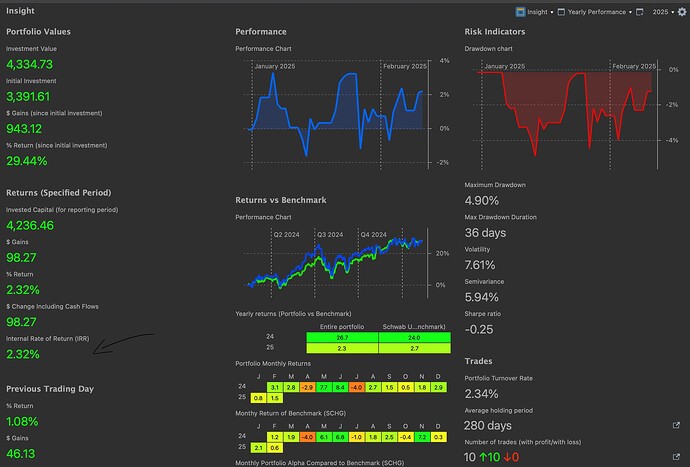Hi, I’m was having the same issue where the IRR shown for YTD vs 2025 are different. I’m also confused why they would be different, but I have an idea.
Reading the PP manual about how IRR is calculated (Money weighted rate of return - Portfolio Performance Manual), I noticed one of the variables used in the formula depends on the reporting period:
RDt = the number of remaining days within the period after CFt
So this seems to suggest having a different reporting period does bring a change to the formula, hence a difference is expected when you set a different reporting period.
I think this is because IRR is an “annualized” rate by its definition. When you set your reporting period as 2025, PP might calculate the IRR as if there are no more data point from tomorrow and the end of 2025. But if you set the reporting period as Q1 2025, PP would calculate the IRR assuming the rest of the 2025 (Q2-Q4) would have the same rate of return as Q1.
For my case, as of near the end of June, these are the IRRs with different reporting periods:
- 2025 → 5.15%
- YTD (~half a year) → 10.22%
- 12/31/2024 - 12/31/2026 (2 years) → 2.52%
As you can see, they are pretty close to the proportion of the time length. If there is no more gain or loss in this year, the IRR is 5.15%. If I assume the second half of this year has the same return as the first half, the IRR is almost doubled to annualized the 6 months data. Similarly, if I double the time period to 2 years, the annualized rate is halved.
For your case, your IRR (“annualized”) for the first quarter is about 4 times of your 2025 IRR.
Please someone correct me if I’m wrong.
BTW, I see you have a widget named “% Return”, but I don’t see such widget in PP. What widget did you rename?

